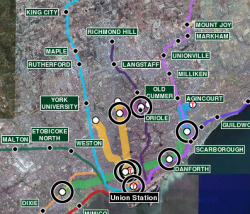
I’ve been reading Steve Munro‘s blog lately, as he discusses the nitty-gritty details of transit planning in Toronto. He brought up an interesting point regarding the extension of the Spadina subway line to York University: there’s already a GO transit line that goes direct from York University to downtown, and GO is a better way of feeding people into the downtown than the subway line. (The Yonge line is already at capacity now.)
So what about GO? I’ve only used it once or twice, and I really didn’t know much about it. I didn’t even have a picture of the network. So, I added the routes to my Toronto transit map. It was an interesting exercise – I’d never thought of Dundas West or Leslie subway stations as interchanges, but they are. You get a different view of the connectivity of the city this way – Agincourt is surprisingly close to downtown (a 27 minutes ride), the Danforth station near my parents’ house is only 11 minutes from downtown, and York University is only 22 minutes from downtown. Living in downtown without a car, there are routes to take you a huge distance from Toronto: Bradford, Milton, Hamilton, and Oshawa are all in reach. If you combined GO with a bicycle, you could get to Lake Simcoe or tour the rural areas around Toronto.
The problem, however, lies in the frequency and the hours of operation. Most of those trains only serve one-way peak hour travel, so you can’t use them for a daytrip from downtown to the hinterlands. And they run so infrequently that you would rarely choose them as an alternative to the subway. As Steve Munro suggests, we really need upgraded service on the GO lines. I’d love to see a service like Lausanne offered, with trains in every direction at reasonable frequencies.
I think it’s interesting that GO is so absent from the lives of Toronto residents. As a local, I was completely oblivious to that network – mostly, I guess, because it was nearly useless to me with its present service levels. It doesn’t even show up on TTC maps, which further marginalizes it. My only awareness of GO was where the tracks disrupted my bike ride, like the dip under the tracks on Woodbine. And yet, it could be a valuable part of carfree life in the city.
This is the exact opposite of me. GO transit was an integral mode of transportation from my home in the suburbs to downtown. Now that I’m downtown, it allows me to visit my parents easily. Incidentally, I never knew that GO trains went through Dundas West until I rented an apartment overlooking the station. GO transit is pretty good along the Lakeshore line, but it is pretty one-sided for most other routes.
FYI the link to the map is broken when viewing the page from the archives.
The URL I get for this page is http://davidpritchard.org/page/1/
Gotcha. Should be fixed now.
Hi David, just read your Go Train post.
I’m starting a blog at http://tucorides.blogspot.com to document commuting by bike to Oshawa for work.
I’m mixing biking with riding the Go Train to Oshawa. Like you I had previously never ridden Go Trains, and was barely aware of their existence. After using it a couple times now, I find Go’s service to Oshawa to be great. The flaw in the ointment though is that my workplace is in north Oshawa (while the Go Station is in the south) – and Durham regional public transit is a bit hit and miss and adds a lot of hassle to my commute.
Ergo part of my desire to simply do it all by myself via bicycle.
The Federation of Metro Tenants Associations is endorsing the NDP’s Anthony Perruzza as the choice for ward 8 councillor.
You can join his campaign or donate by calling 416-636-2255 http://www.anthonyperruzza.com
They are saying that present councillor Peter Li Preti gets a lot of funding from NHD Developments owned by Liberal finance minister and slum landlord Greg Sorbara and his family plus from other slumlords.
They also feel the reason for Li Preti and Greg Sorbara’s government supporting the strange subway extension to Jane and Steeles is that it will substantially improve the value of the many properties owned by Greg Sorbara and his family in the Keele/Finch and Jane/Steeles areas all at taxpayer expense.
Updates, both recent and older: